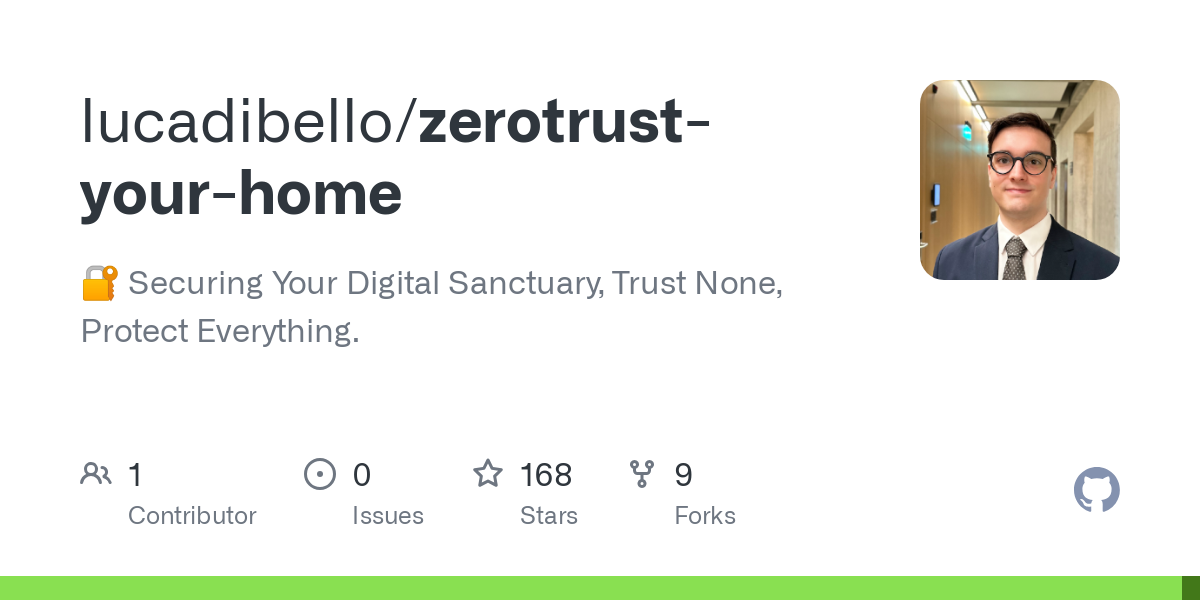This is a decent writeup on applying “Zero Tust” principles to a home lab using mostly open source tools. I’m not the author, but thought it was worth sharing.
The document is filled with so much meaningless fluff that it’s annoying to read and was probably written by chatgpt and the cover image is AI generated: I don’t think there’s anything useful here.
It looks like something for a LinkedIn post.
this is a very bad article. It talks about “zero trust” but then suggests you to use corporate software, the cloud, sketchy russian apps to monitor your traffic at home. Also, I am not spending 2 hours a day going through my logs, nor I want a VM/container with 8GB of ram wasting 40% of my GPU on grafana.
I, too, don’t love the use of AWS/Cloudflare, while I get that you can simply replace AWS S3 with something else for backups, this server setup is innately based on using Cloudflare.
Maybe I should do a write up on my setup, as I don’t use Cloudflare or AWS. I do use backblaze and OVH
Yes, please!
Will see what I can do, will probably be on https://homelab.horwood.biz/
have made a start in documenting what I run, not sure who much of how it runs you want
What is a good alt for cloudflare here tbh?
I’ve done wire guard, and tor service to obfuscate the network, and crowdsec for a good external firewall, and linkerd gateway to actual services (and keycloak for sso).
Besides adding gotelaport for more fine grained access, idk what else you could do, but even then idk if its still competitive as someone else’s network taking your ddos loads lol
A cheap VPS with headscale. Or just ZeroTier.com free plan.
ZeroTier looks super cool!
Amused that the ‘This is private! You no hack!’ banner nonsense isn’t a dead thing yet.
Life protip: the bots scanning your shit will absolutely not care, and shockingly, criminals will also absolutely not care.
When done correctly, the banner is actually a consent banner. It’s a legal thing, not necessarily trying to discourage criminals. It’s informing users that all use will be monitored and it implies their consent to the technology policies of the organization. It’s more for regular users than criminals.
When it’s just “unauthorized access is prohibited”, though, especially on a single-user server? Not really any point. But since this article was based on compliance guidelines that aren’t all relevant to the homelab, I can see how it got warped into the empty “you no hack” banner.
deleted by creator
Based on the complexitiy of this setup, you need to be quite enthusiastic about your homelab.
I’d say anyone wanting to go this deep into a home monitoring setup will likely go with what works best for them instead of reading and following the entirety of this guide… I’m one of those people…
Wrote my own log parsing software to put into a database, display and alert through grafana, which is alerting through a homemade webhook that sends a notification to ntfy based on severity… And I also use uptime Kuma like mentioned, but my notifications channel is ntfy. No cloudflare for my internal services, only wireguard to connect home and use everything. And definitely no telegram.
Plenty of other stuff setup, but my security alerts and monitoring rely heavily on the syslog/grafana server which helps me monitor everything.
Acronyms, initialisms, abbreviations, contractions, and other phrases which expand to something larger, that I’ve seen in this thread:
Fewer Letters More Letters CGNAT Carrier-Grade NAT DNS Domain Name Service/System IP Internet Protocol NAS Network-Attached Storage NAT Network Address Translation SSL Secure Sockets Layer, for transparent encryption TLS Transport Layer Security, supersedes SSL VPN Virtual Private Network VPS Virtual Private Server (opposed to shared hosting)
[Thread #957 for this sub, first seen 8th Sep 2024, 14:05] [FAQ] [Full list] [Contact] [Source code]
This is more complicated than some corporate infrastructures I’ve worked on, lol.
Nice write-up. I’d take this as a blueprint. Anyone can swap 3rd-party services to their like (e.g. headscale, xmpp bot on that vps, backblaze s3, etc.) and extend upon (e.g. oidc providers, mailboxes, arr suite, etc.)







